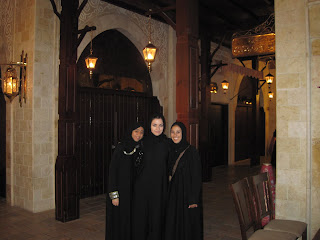Hey guys! Eve here, your cultural correspondent. I’ve got another juicy societal topic for today’s discussion: women. I decided it was finally time to take it on…or try to. It’s such a complex topic I know I won’t be able to cover all the facets in one post.
Before I get all academic, I just want to share how optimistic, sophisticated, and tenacious we’ve found the women here to be. I’d be writing this post all day if I were to talk about everyone who has inspired me already, so I’ll focus on one for now: Kholoud Attar. Kholoud graduated from Dar Al-Hekma four years ago with a degree in graphic design. She was back on campus yesterday to present as a guest speaker at our workshop. Kholoud is the founder and editor of Design Magazine, a high-end fashion/ design/political commentary publication. In the three years since she started the magazine, distribution has grown from 2,000 copies to 40,000, and it now reaches multiple countries in the Middle East.
Although she impressed me on many levels—starting a business, starting a business in her early 20s, starting a business as a woman in Saudi Arabia, starting a business that has created jobs—what impressed me most was her willingness and desire to tackle sensitive cultural issues. The latest edition of her magazine addressed censorship (the Minister of Information closely monitors the media) and another edition manipulated the image of the Saudi flag in order to start a dialogue about what Saudi Arabia stands for (shown below). As a result of her “questioning the status quo”, Kholoud has actually been called into heated meetings with the country’s Minister of Information. And while she’s managed to talk her way out of the hot seat, she’s not backing down on the issues. She and her peers are eager for change, and they’re using Design Magazine to propel it. Kholoud isn’t letting her age or her gender get in the way.

Even so, it’s still a big challenge to do business in Saudi Arabia as a woman. The Businesswomen's Center at the Jeddah Chamber of Commerce reports that only 14% of women are employed. The number’s likely going to grow, with the government making strong efforts to improve women’s educational and professional opportunities, including the May 15th opening of Princess Noura University in Riyadh (photo below), which is the largest all-women’s university in the world.

One of the main roadblocks to women's employment, according to a Monitor report, comes in the form of gender-specific constraints within the regulatory environment. Until quite recently women had to appoint a male manager in order to “run” their business. Even now, if a woman walks into the business permitting office to try to start a business, she’s laughed or yelled at. She has to push hard in order to exercise her rights. Furthermore, since women can’t drive and the Kingdom is devoid of public transportation, it’s hard for them to get around locally for day-to-day business activities. And when it comes to international travel, Saudi women must get permission from their legal guardian. We’ve only been here for 9 days and have felt constrained in our ability to get around, and we have a dedicated driver to get us to and from the college! Many women can’t afford a driver.
Most government positions are not open to women and until recently, the country had strict segregation laws that required men and women to be separated in the workplace. Some companies do mix the sexes, but men are still predominant in both numbers and status. Thus, most women who are employed in Saudi Arabia work as teachers or nurses. Interestingly, many of them have access to loads of capital (Saudi Arabia is a very wealthy country after all, and according to Amnesty International women own 40% of the nation’s private wealth) so entrepreneurship—especially social entrepreneurship—is another common pursuit.
The women we’ve spoke with thus far—faculty, staff, students and women from the community—are very optimistic about the future. They see things changing, albeit slowly, and believe more and more opportunities will open up to women. Given the amazing women we’ve met, I can’t imagine that won’t be true.
















































